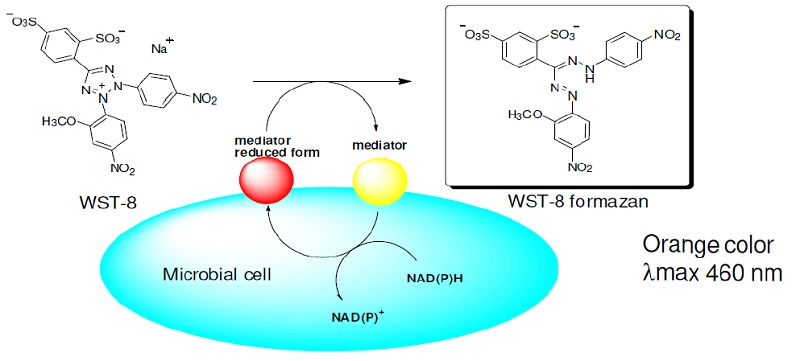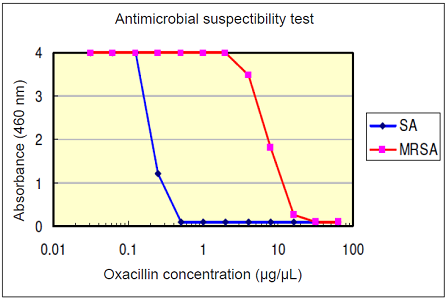General Information
Microbial Viability Assay Kit-WST provides colorimetric detection of microbial metabolism.WST-8 employed in this kit as a colorimetric indicator produces a water-soluble formazan dye upon reduction in the presence of an electron mediator, as shown the following figure. The amount of the formazan dye generated is directly proportional to the number of living microorganism.
This kit contains all requirements, and allows quick and easy measurement.

Kit Contents
| 100 tests | 500 tests | |
| WST solution | 1 ml x 1 | 1 ml x 5 |
| Electron Mediator reagent (DMSO solution) | 0.1 ml x 1 | 0.5 ml x 1 |
Storage Condition
Store at 0–5 ℃
Required Equipment and Materials
- Plate reader (450–490 nm filter)
- 96-well microplate
- Incubator
- Micropipette (10 μl, 200 μl) and multi-channel pipette (200 μl)
- 1.5 ml tube
Precaution
- WST-8 may react with reducing agents and generate WST-8 formazan. If the background O.D. is quite high (> 0.5), please remove the reducing agents from the sample.
- Be careful not to introduce bubbles to the well. It causes experimental error.
- The sensitivity (O.D. value) depends on the species of microorganisms or the metabolic activity. Please optimize the number of cells and coloring reaction time for each experiment.
Viability Assay
Preparation of Coloring reagent
Mix 9 parts of WST solution and 1 part of Electron mediator reagent in a freshly prepared 1.5 ml tube. This solution is stable at 0–5 ℃ for 1 month.
- Since 10 μl of Coloring reagent is added to one well of a 96-well microplate, please calculate and prepare the necessary volume for the assay.
- In case using the following microbial cells, make a 8-fold diluted electron mediator reagent with DMSO or sterile water, and prepare the Coloring reagent by mixing 9 parts of WST solution and 1 part of the diluted electron mediator.
Gram-positive bacteria, Fungi and low-response bacteria strains such as Vibrio parahaemolyticus
Microbial cell viability assay
- Prepare the appropriate number of cells suspension and inoculate it (190 μl) in each well of a microplate.
- Add 10 μl of Coloring reagent to each well.
- Incubate the plate in the incubator (37 ℃ or appropriate temperature).
- Measure the absorbance at 450 nm using a microplate reader.
Microorganisms evaluated with Microbial Viability Assay Kit-WST
Fungi:
Candida utilis, Saccharomyces cerevisiae, Zygos accharomyces rouxii, Candida albicans, Candida krusei, Candida parapsilosis
Gram-positive bacteria:
Bacillus cereus, Bacillus subtilis, Corynebacterium glutamicum, Enterococcus faecalis, Lactobacillus casei, Listeria monocytogenes, Micrococcus luteus, Staphylococcus aureus, Staphylococcus epidermidis
Gram-negative bacteria:
Acetobacter sp., Escherichia coli, Klebsiella pneumoniae, Proteus mirabilis, Pseudomonas aeruginosa, Salmonella enteritidis, Salmonella typhimurium, Serratia marcescens, Vibrio parahaemolyticus, Yersinia enterocolitica
Antimicrobial Susceptibility
For Gram-negative bacteria
- Prepare the number of microbial cells of 107 CFU/ml by using McFarland standards.
(e.g. Adjust the absorbance at 550 nm to 0.125 of microbial cells suspension with sterile saline and make an additional 10-fold diluted cells suspension of it with sterile saline. The number of microbial cells is 107 CFU/ml.) - Prepare the various concentrations of antibiotic in Mueller-Hinton broth.
(e.g. 64, 32, 16, 8, 4, 2, 1, 0.5, 0.25, 0.12, 0.06 μg/ml ) - Dispense 180 μl of the antibiotic in Mueller-Hinton broth to each well.
- Inoculate 10 μl of the cell suspension (107 CFU/ml) to each well (final cell density: 105 CFU/well).
- Incubate the plate at appropriate temperature for 6 hours.
- Add 10 μl of Coloring reagent to each well and incubate the microplate for additional 2 hours*.
- The incubation time for colorimetric reaction depends on microbial species and its metabolic activity.
- Measure the absorbance at 450 nm using the microplate reader.
For Gram-positive bacteria, Fungi and Vibrio parahaemolytics
Make a 8-fold diluted electron mediator reagent with DMSO or sterile water, and prepare the Coloring reagent by mixing 9 parts of WST solution and 1 part of the diluted electron mediator.
Follow the above procedure “for Gram-negative bacteria”.
-
MIC (Oxacillin concentration μg/mL) Microbial Viability
Assay Kit-WSTMicrodilution
methodSA 0.5 0.5 MRSA 32 64 SA: Staphylococcus aureus subsp. aureus (NBRC12732),
MRSA: Methicillin-resistant Staphylococcus aureus subsp. aureus (FJCM8702)
Reference
- T. Tsukatani, H. Suenaga, T. Higuchi, T. Akao, M. Ishiyama, T. Ezoe and K. Matsumoto, "Colorimetric cell proliferation assay for microorganisms in microtiter plate using water-soluble tetrazolium salt", J of Microbiol. Methods, 2008, 75, 109.
- T. Tsukatani, T. Higuchi, H. Suenaga, T. Akao, M. Ishiyama, T. Ezoe and K. Matsumoto, "Colorimetric microbial viability assay based on reduction of water-soluble tetrazolium salts for antimicrobial susceptibility testing and screening of antimicrobial substances", Anal. Biochem., 2009, 393, 117.
This kit was developed by joint research with Fukuoka Industrial Technology Center.
Frequently Asked Questions / Reference
M439: Microbial Viability Assay Kit-WST
Revised Aug., 31, 2023


 Hidden sections will not be printed.
Hidden sections will not be printed.


